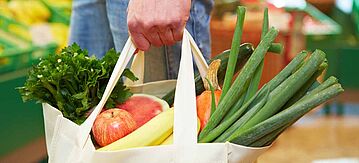Consumer Protection

Heavy metals such as lead, cadmium and mercury are among the environmental contaminants in foodstuffs which can pose health risks for consumers depending on their concentrations. Heavy metals are elements of the Earth’s crust, and as such occur naturally in the environment and consequently also in food. However, they can also be anthropogenic, i.e. their presence in the environment is a result of human activities. Heavy metals can also be introduced into foodstuffs through contaminated additives. It is not possible to clearly trace the pathways of heavy metals into foodstuffs.
The largely naturally occurring mercury content of fish in the world's oceans, a source of food for humans, is so low that it does not pose a health risk. This does not apply, however, to fish in highly contaminated waters or to long-lived species at the top of the food chain such as sharks, swordfish and the Atlantic halibut. Relatively high concentrations of mercury can be found in these species. To protect consumer health, Germany therefore laid down maximum levels of 1 mg/kg for mercury concentrations in fisheries products as early as 1975. A corresponding EU-wide maximum level was introduced in 1993.
Moreover, since April 2002, maximum levels for lead and cadmium in various foodstuffs such as cereals, vegetables, fruits, food supplements, foods for infants and young children, meat and fisheries products have applied EU-wide to protect human health. These maximum levels are also laid down in Commission Regulation (EU) 2023/915 of 25 April 2023 on maximum levels for certain contaminants in food and repealing Regulation (EC) No 1881/2006. When lead, cadmium and mercury concentrations were measured as part of the annual food monitoring, only a small share of the food samples were found to exceed the maximum levels for these heavy metals. The concentrations in the analysed foodstuffs are at roughly the same low level as in past years.
Environmental contaminants also include persistent organic pollutants (POPs) such as health-damaging dioxins and polychlorinated biphenyls (PCBs), and per- and polyfluoroalkyl substances (PFAS). Dioxins are unwanted and unavoidable by-products which must be minimised. Their release is primarily the result of certain industrial thermal or combustion processes, but can also be caused by forest fires and volcanic eruptions. Dioxins are not and have never been intentionally produced. In contrast, PCBs were manufactured for a specific purpose, mainly as non-burning, non-conductive viscous liquids in transformers and hydraulics. Pollution legacies are the main source of dioxin and PCB emissions. Some of these unwanted substances are chemically very stable, highly toxic and very persistent. Both groups of compounds accumulate in the fatty tissue of humans and animals. People generally absorb these harmful substances by eating food containing animal fat. To protect consumers, legally binding maximum levels have been in place since 1988 for non dioxin-like PCBs in many foods of animal origin.
These national limit values were supplemented in 2002 by Europe-wide binding maximum levels and voluntary action levels for dioxins and, since 2006, dioxin-like PCBs in various foodstuffs. In early 2012 most national maximum levels for non dioxin-like PCBs were replaced by more stringent EU-wide maximum levels. These maximum levels are now also enshrined in Regulation (EU) 2023/915.
The analysis of various heavy metals, dioxins and PCBs measured in air, water and soil shows that the environmental protection measures taken so far have been successful. Overall environmental pollution with these substances, also referred to as background concentration, has been declining for years and is now very low. This consequently leads to relatively uniform low contamination levels with these substances nationwide in most foodstuffs. This means that today, background concentration does not generally lead to these harmful substances exceeding admissible levels in food.
Harmful per- and polyfluoralkyl substances (PFAS) can enter food through water, air, soil and sediments. Since the end of the 2000s, substantial restrictions within Europe have reduced the release of especially harmful types of this substance group into the environment. Maximum levels for PFAS in certain foodstuffs have applied since 1 January 2023. These are now also laid down in Regulation (EU) 2023/915.
